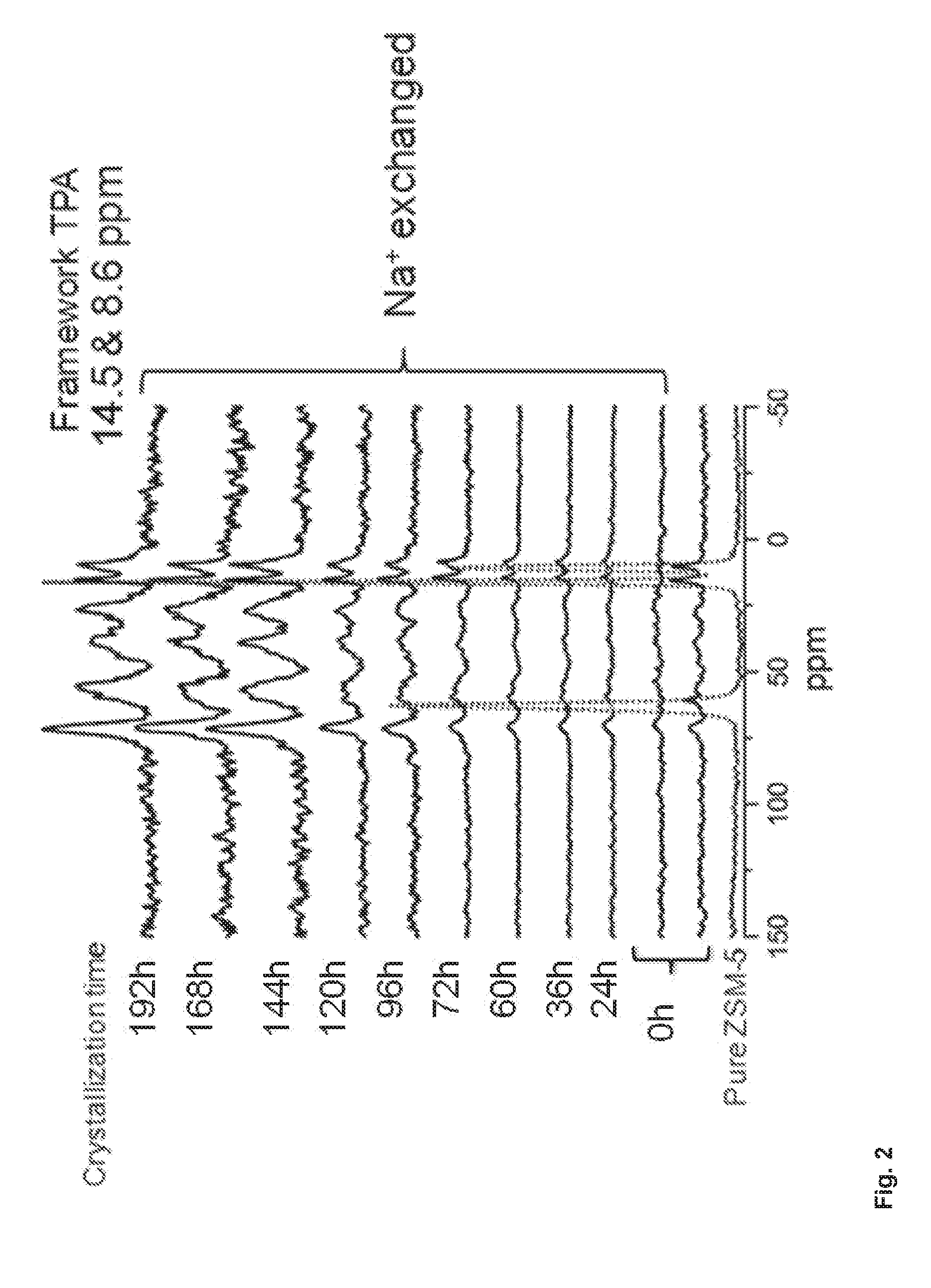Catalyst compositions comprising small size molecular sieves crystals deposited on a porous material
a technology of molecular sieves and crystals, which is applied in the direction of hydrocarbon preparation catalysts, physical/chemical process catalysts, bulk chemical production, etc., can solve the problems of limited access to active sites of bulky molecules, limit the catalytic performance of molecular sieves such as zeolites, and limit reaction rate and yield, so as to improve activity and selectivity, the effect of improving the surface area
- Summary
- Abstract
- Description
- Claims
- Application Information
AI Technical Summary
Benefits of technology
Problems solved by technology
Method used
Image
Examples
example 1 (
According to Invention)
Preparation of the Catalyst Composition with a Precursor Solution being Maturated Before being Impregnated on Modified Porous Material
[0210]A catalyst composition with a porous material being Siralox TH 30 (Sasol, Al2O3 / SiO2-70 / 30 wt %) on which crystals of ZSM-5 molecular sieves are dispersed was prepared according to the following procedure.
[0211]The solution containing the precursor of molecular sieve (ZSM-5 precursor solution—4.5(TPA)2O:25SiO2:0.25Al2O3:430H2O:Si / Al=50) was prepared by mixing TPAOH (tetrapropylazanium hydroxide; CAS [66082-78-8]), H2O, Aluminium sulphate [10043-01-3], and TEOS (tetraethoxysilane; CAS [9044-80-8]). The ingredients were added gradually according to mention order and hydrolyzed at room temperature (RT) for 1 h with vigorous stirring and then closed and stirred for another 3 h. Prior to its use on the porous material, this solution was maturated at 100° C. for various maturation: 12 h, 36 h, 48 h, 72 h, 96 h, 120 h, 144 h. 168...
example 2 (
According to Invention)
Catalytic Tests of Materials Prepared According to Example 1
[0219]Catalytic tests of cracking of the TiPBz were performed on the catalyst composition prepared (see FIG. 4). It appears that the catalyst compositions prepared with a longer crystallisation time (more than 36 h) have a higher activity than the initial Siralox TH 30 (600° C.). Without willing to be bound to any theory, it is interpreted that the catalysts with longer crystallisation time have more acid sites and more developed surface area (table 3-4). This higher acidity originates from the small crystals of molecular sieve deposited on the surface of the Siralox TH 30. The catalyst compositions prepared by deposition of the crystal of molecular crystals on Siralox TH 30 present a higher conversion than the Siralox TH 30.
example 4 (
According to Invention)
Preparation of the Catalyst Composition with a Precursor Solution being Maturated Before being Impregnated on Modified Porous Material with One or More than One Impregnations
[0221]A series of catalyst compositions with a porous material being Siralox TH 30 (Sasol) on which crystal of molecular sieves are dispersed by repeating the deposition step.
[0222]ZSM-5 precursor solution was prepared by mixing TPAOH (tetrapropylazanium hydroxide; CAS [66082-78-8]), H2O, Aluminium sulphate, and TEOS (tetraethoxysilane; CAS [9044-80-8]). The ingredients were added successively according to mentioned order and hydrolyzed at RT for 3 h with vigorous stirring. Prior to its use, this solution was maturated at 100° C. for 12 h. Dynamic Light Scattering (DLS) shows that particles smaller than 10 nm with a narrow particle size distribution are present in the seed solution aged for 12 h at 100° C.
[0223]The porous material used was commercial Siralox TH 30 a silica alumina oxide fr...
PUM
| Property | Measurement | Unit |
|---|---|---|
| pore diameters | aaaaa | aaaaa |
| diameter | aaaaa | aaaaa |
| pore diameter | aaaaa | aaaaa |
Abstract
Description
Claims
Application Information
 Login to View More
Login to View More - R&D
- Intellectual Property
- Life Sciences
- Materials
- Tech Scout
- Unparalleled Data Quality
- Higher Quality Content
- 60% Fewer Hallucinations
Browse by: Latest US Patents, China's latest patents, Technical Efficacy Thesaurus, Application Domain, Technology Topic, Popular Technical Reports.
© 2025 PatSnap. All rights reserved.Legal|Privacy policy|Modern Slavery Act Transparency Statement|Sitemap|About US| Contact US: help@patsnap.com



